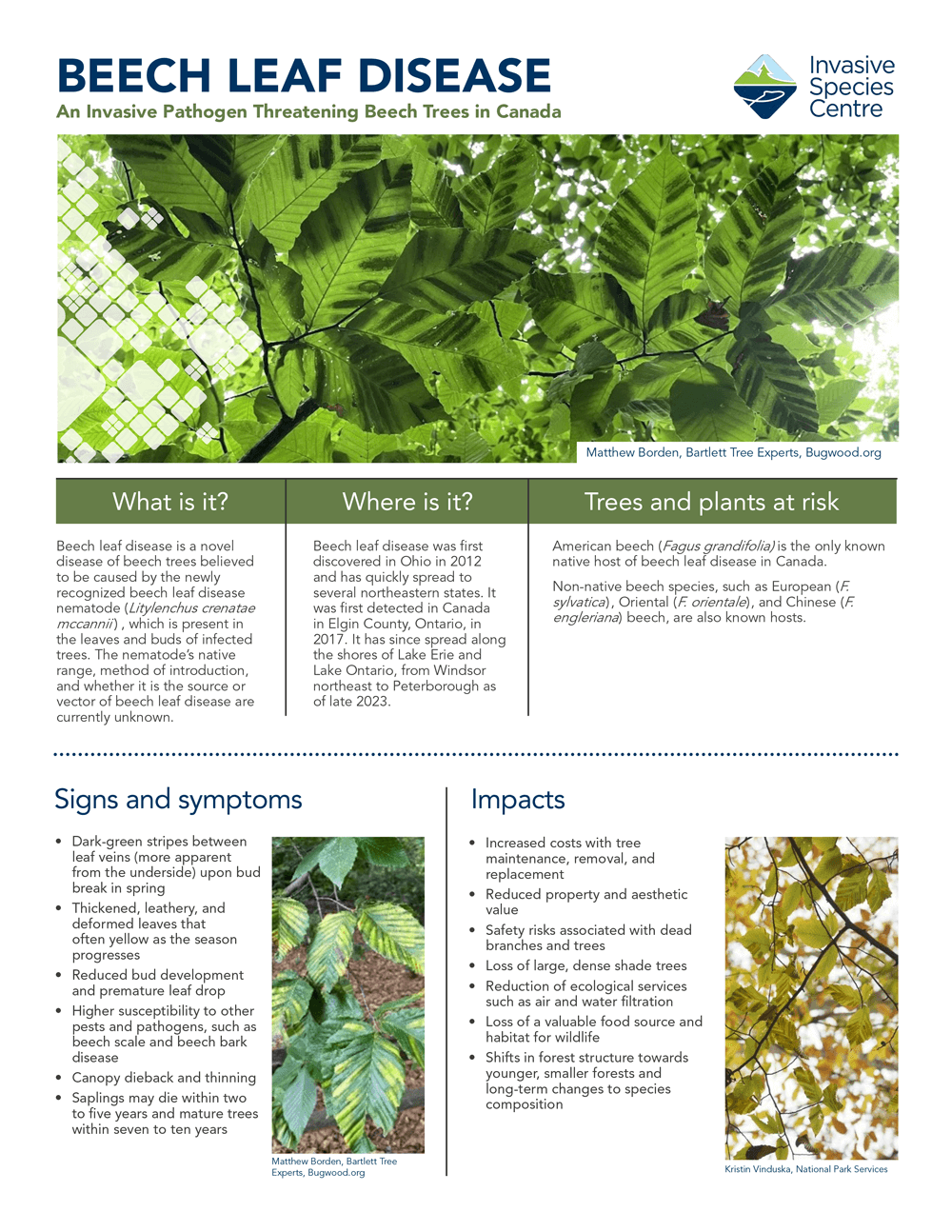August 22, 2025

Beech leaf disease
An invasive pathogen threatening beech trees in Canada
Beech leaf disease is a novel disease of beech trees believed to be caused by the newly recognized beech leaf disease nematode (Litylenchus crenatae mccannii), which is present in the leaves and buds of infected trees. The nematode’s native range, method of introduction, and whether it is the source or vector of beech leaf disease are currently unknown.
Beech leaf disease was first discovered in Ohio in 2012 and has quickly spread to several northeastern states. It was first detected in Canada in Elgin County, Ontario, in 2017. It has since spread along the shores of Lake Erie and Lake Ontario, from Windsor northeast to Peterborough as of late 2023.
If you see signs and symptoms of beech leaf disease, report your sighting to:
EDDMapS at www.eddmaps.org.
Beech leaf disease was first discovered in Ohio in 2012 and has quickly spread to several northeastern states. It was first detected in Canada in Elgin County, Ontario, in 2017. It has since spread along the shores of Lake Erie and Lake Ontario, from Windsor northeast to Peterborough as of late 2023.
If you see signs and symptoms of beech leaf disease, report your sighting to:
EDDMapS at www.eddmaps.org.
Trees and plants at risk
American beech (Fagus grandifolia) is the only known native host of beech leaf disease in Canada.Non-native beech species, such as European (F. sylvatica), Oriental (F. orientale), and Chinese (F. engleriana) beech, are also known hosts.
Signs and symptoms
- Dark-green stripes between leaf veins (more apparent from the underside) upon bud break in spring
- Thickened, leathery, and deformed leaves that often yellow as the season progresses
- Reduced bud development and premature leaf drop
- Higher susceptibility to other pests and pathogens, such as beech scale and beech bark disease
- Canopy dieback and thinning
- Saplings may die within two to five years and mature trees within seven to 10 years
Impacts
- Increased costs with tree maintenance, removal, and replacement
- Reduced property and aesthetic value
- Safety risks associated with dead branches and trees
- Loss of large, dense shade trees
- Reduction of ecological services such as air and water filtration
- Loss of a valuable food source and habitat for wildlife
- Shifts in forest structure towards younger, smaller forests and long-term changes to species composition
Life history of the disease
Life cycle- Nematodes feed on leaf tissue between veins, causing damage
- Damage occurs in the buds, and symptoms don’t progress after the buds open
- Nematodes are present before symptoms occur, so there’s typically a delay between infestation and detection
- Populations increase from spring to fall, and then they overwinter in buds and leaf litter
Life history of the disease
Spread
- Research into the spread of beech leaf disease is ongoing. The leading theories are:
- Invertebrates such as mites carrying the nematodes, potentially further assisted in travel by the invertebrates attaching themselves to birds
- Birds ingesting buds containing nematodes and distributing them in their feces
- Movement of beech saplings (wild and nursery), firewood, other natural wood products, leaf litter, and soil
- Wind and rain accelerating spread locally
What you can do
- Solutions are being studied; however, no cures have been discovered. In the meantime, the best approach is to prevent the spread and reduce infection in areas where the disease occurs: Inspect trees closely for signs and symptoms
- Restrict the movement of beech saplings (wild and nursery), firewood, other natural wood products, leaf litter and soil
- Increase the diversity of tree species
- Quarantine areas with diseased trees
 For more information on beech leaf disease visit:
For more information on beech leaf disease visit:Invasive Species Centre: www.invasivespeciescentre.ca
Ontario: www.ontario.ca/page/beech-leaf-disease
